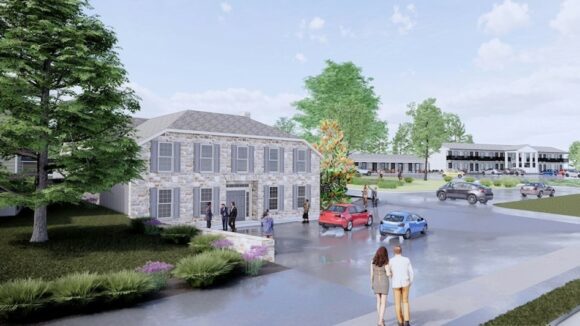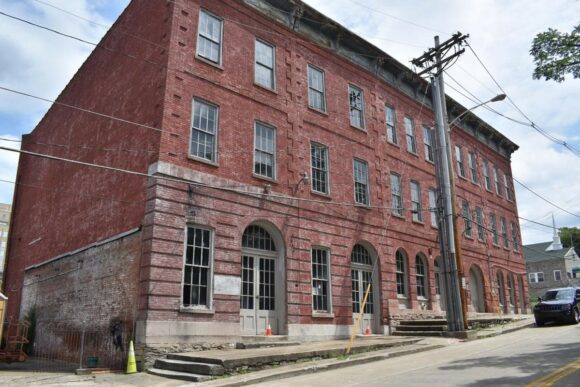The Peale
62
Jobs Created
$928,795
Tax Impact
$2,632,299
Income Generated
$3,522,281
GDP Added
$7,016,186
Output Generated
Located in Baltimore, Maryland, The Peale is an innovative, award-winning museum that amplifies and presents the voices and stories of Baltimore’s diverse communities, helping preserve the whole story of the City for future generations. From its construction in 1814 as the Nation’s first museum building to its transformative role in the history of African American life in Baltimore, the museum has been a pioneer of progress for nearly two centuries. Through the Historic Rehabilitation Tax Credit (HTC), the building is now The Peale, “Baltimore’s Community Museum,” celebrating the unique history of Baltimore, its people and its buildings.
A Brief History
The Peale building was originally opened in 1814 as the first purpose-built museum in the United States called the Baltimore Museum and Gallery of Fine Arts. It was founded by artist and entrepreneur Rembrandt Peale of the Peale family of artists, museum innovators and entrepreneurs.
His father, Charles Willson Peale, had opened the first museum in the country in his home/studio in Philadelphia in 1784 and developed the diorama display format to show natural history specimens in their habitats. The Peales’ Philadelphia and Baltimore museums were the first in the country to exhibit prehistoric animals.
The Peales were also quick to adopt new technologies. Adding to its long list of firsts, the Baltimore museum was the first to use gaslight to illuminate its galleries. The success of the new technology led Rembrandt Peale to found the Baltimore Gas and Light Company (now BGE) in 1816 and install the first city-wide gas streetlight network in the country, giving rise to Baltimore’s nickname, “Light City.” In addition, the Peales were the first to use physiognotrace machines to generate silhouette “selfies” as instant souvenirs for museum visitors. Moses Williams, enslaved in the Peale household, grew from a physiognotrace operator to become a successful silhouette artist, earning his freedom a year earlier than stipulated by Pennsylvania law under the 1780 gradual emancipation act.
In 1829, the building was sold to the City to serve as Baltimore’s first City Hall. Following the construction of a new City Hall, the Peale Museum hosted the first public school in the state of Maryland to offer a secondary school education to people of color. It became Baltimore’s first Municipal Museum in 1930 and was shuttered in 1997. The Peale building sat largely vacant for 20 years until 2017 when it began exterior renovations while hosting exhibitions, programming and events centered on the stories of Baltimore’s unique people and places.
About the Rehabilitation
In partnership with the City’s Department of General Services, The Peale began exterior renovations in 2017. The roof was replaced, and the exterior masonry, windows and doors were renovated to stabilize the building’s envelope. Some of the improvements were intended to help the building last for another 200 years, including the use of extra-strong “aquarium glass” on the first-floor windows meant to protect the building in case of flooding. Interior renovations included installing a new elevator, new lights, a new HVAC system and an updated fire safety system. Floors were restored, and plasterwork was repaired, giving the interior a similar look it had in the 1800s. For the second floor, Baltimore designer David Wiesand of McClain Wiesand created a chandelier that evokes the gaslit “Ring of Fire” that had been in the building. The final phase of renovation was completed in early 2022.
About The Peale
Today, The Peale is home to the world’s largest digital collection of Baltimore stories and the only museum dedicated to Baltimore’s intangible cultural heritage: the stories and voices of the City’s diverse communities. Since reopening in 2017, The Peale has once again become a cultural haven for the City, nurturing creativity and innovation through its various programs, including storytelling, exhibitions tours, and immersive experiences, as well as capacity-building workshops and professional development. The Peale has published more than 2,400 authentic stories on a number of digital platforms, including its Be Here Stories web and iOS app, social media platforms and even augmented reality experiences. As a member of the Association of African American Museums, the building now hosts a core exhibit telling the story of its role in African American education in both Baltimore and the State of Maryland. Accolades include:
- Maryland Historical Trust, Excellence in Institutional Rehabilitation Award, 2023. To watch the award ceremony, click here.
- Baltimore Heritage, Preservation Award, 2022
- Preservation Maryland, Stewardship Award, 2019
Community Impact
Thanks to the HTC, the rehabilitation of the historic Peale building has brought valuable resources and opportunities to the Baltimore community. The innovative cultural center offers diverse programming, including exhibitions, performances, talks, immersive experiences and other creative media. The rehabilitation has helped create more than 60 jobs and has significantly impacted the local economy. Programs like Accomplished Arts Apprentices and The Lab at The Peale have helped further the museum’s positive impact on the Baltimore community.
Accomplished Arts Apprentices Program
The Accomplished Arts Apprentices (AAA) program enables young people from Baltimore’s disinvested communities to earn while they learn valuable skills in gallery installation and historic preservation. Apprenticeships at The Peale provide non-traditional mentorship and vocational training in fine art, curatorial practice, art installation, logistics and historic building preservation to develop transferable skills using arts as the driving force. The program aims to increase equity and inclusion in the arts, creative and preservation trades with a specific focus on people from marginalized communities in Baltimore. Apprentices are paid a living wage while gaining access to meaningful, creative careers.
The Lab at The Peale
The Lab at The Peale is a platform for innovating the museum experience through research, evaluation, experimentation, and testing of next-generation museum experiences and exhibition designs with community and cultural heritage partners. Centering storytelling and community voices, the Lab operates online, in the galleries and garden of the historic Peale Museum, and at outdoor and partner sites across Baltimore and beyond. Students in the AAA program based at The Peale help build and install prototypes and new exhibits. The Lab furthers The Peale’s work to evolve the role of museums in society, helping them better serve the communities, creators and culture keepers of today.
About The Peale Nonprofit
The Peale is a 501(c)(3) tax-exempt, nonprofit corporation established to restore the historic Peale Museum building as a center to celebrate the unique history of Baltimore, its people, and places. By creating a more inclusive cultural record of the city, The Peale aims to help people everywhere see Baltimore in a new light. For more about The Peale, visit its website.
Project Type:
Historic RehabilitationTax Credit Type:
FederalAddress:
225 Holliday Street
Baltimore, Maryland 21202


